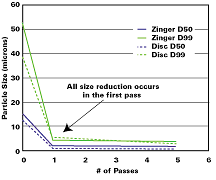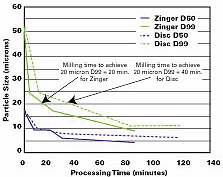Independent Performance Evaluation of the Zinger Horizontal Media Mill

The Zinger Pilot Mill vs. A Competitor’s Pilot Mill
Ribek Development evaluated the Zinger® SV-4 pilot horizontal media mill against a leading competitor’s pilot horizontal media mill. Ribek selected the competitor’s model because of its advanced disc design. It also features the competitor’s patented over-cup, which improves the function of the media separator. This model presented the most realistic challenge for the Zinger horizontal mill.However, direct apple-to-apple comparisons of the two mills are difficult because of their design differences. Differences in agitator-shaft designs, chamber volume, connected horsepower, media separator design and chamber geometry contribute to the complexity of the comparison.
Ribek Development performed three milling trials using each mill. The calcium carbonate used in Trial 1 is Specialty Minerals’ Marblewhite 325. It represents an easy-to-mill material and is used in a variety of paint and polymer applications.
Zeolite, used in Trial 2, is a ceramic-like material that is considered very difficult to grind. Starch, used in Trial 3, is Stanley Koldex 60LB. It is a difficult-to-mill vegetable material used in water-activated adhesive labels. Particle size is crucial to the performance of this material in its adhesive applications.
The three trials were conducted in a manner that equalized many factors that affect mill performance. For example, the same type and size media were used for both mills; the batches were prepared using the same formula; the batch size was proportional to the chamber free-volume for trials processed in recirculation mode (this ensures that the ratio of milling time to residence time was the same for both mills); and the amount of slurry purged was measured to ensure a known batch size. Results of the trials show that, based on particle size reduction, the Zinger horizontal media mill, on average, was twice as effective as the competitor’s mill.

Calcium Carbonate Trial Results
The milling results for this easy-to-mill material were almost identical for the two mills. The slight difference in particle size was within the measurement error. It took only one pass with each mill to reach the arbitrary target particle size. Ribek researchers suggest that to observe any discernible difference in mill capability, the trial would have to be conducted at very low residence times, i.e., < 30 seconds with a very large batch size. See Figure 1.
Zeolite Trial Results
The zeolite slurry was processed in recirculation mode to avoid settling between passes and to accommodate the large number of passes anticipated. The Zinger horizontal media mill achieved the targeted particle size in half the milling time of the competitor’s horizontal media mill. The mean and maximum particle sizes from the Zinger horizontal media mill were significantly smaller throughout the milling process than the particles in the competitor’s mill. See Figure 2.
Starch Trial Results
The starch slurry was processed in recirculation mode to avoid settling between passes and because a large number of passes was anticipated. The Zinger horizontal media mill in a 30-minute milling test produced smaller mean and maximum particle sizes. The competitor’s media mill was not able to achieve the same mean particle size (6.5m) in twice the milling time. See Figure 3.For more information on media mills, contact Morehouse-COWLES, a Division of MFIC Corp., Business Development Group, PO box 9101, 30 Ossipee Road, Newton, MA 02464-9101; phone 800/625.4819; fax 617/965.1213; visit www.morehousecowles.com; e-mail info@mfics.com.
Looking for a reprint of this article?
From high-res PDFs to custom plaques, order your copy today!



